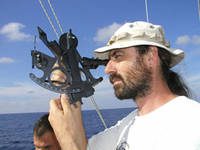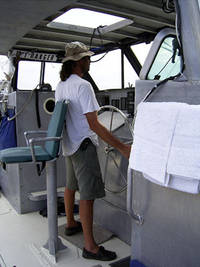April 18, 2005
The art of sailing with Captain Nuño.
Nuño Ramos is the captain of the Oceana Ranger. His connection with Oceana is the result of years of engagement in environmental causes and, more specifically, with the marine environment. Also, of course, because of his friendship with Xavier Pastor. A few years ago Nuño was one of his collaborators in the founding of MarViva, the organization of civil park rangers that cooperates with the governments of Costa Rica, Panama, Honduras and other Central American countries to protect the waters of the
Marine Conservation Corridor (in the Pacific) and the Mesoamerican Corridor (in the Atlantic).
Already we are practically halfway through the Transoceanic Expedition, which began mid-January in Los Angeles. The crossing of the Atlantic will mark one of the key moments for the expedition crew. And Nuño, telecommunications engineer, Madrid native, 41 years old, will be at the Ranger’s helm during the crossing, with the Ranger headed for the archipelago of the Azores. Amidst the frenetic activity of the crew I spoke to him for a few moments.

Why did you decide to join this Transoceanic Expedition?
I didn’t have to think about it much. I was convinced that sailing aboard the Ranger with Oceana’s team of divers and researchers was a fantastic opportunity to work in defense of the oceans. And we’re already seeing, with great satisfaction, the first results. Millions of people in Spain, South America, Central America and the United States are already watching the first underwater films produced by our divers. Oceana’s is an important mission: show people the fascinating marine world hidden below the surface, and warn them that all of this biodiversity is facing serious threats and we have to do something to protect it. In addition to all that, from a technical point of view, as captain, Oceana’s expedition offers me the chance to undertake the thrilling journey of an Atlantic crossing.
What is the Ranger like from a sailing perspective?
It is a solid, resilient boat, made for ocean sailing: keep in mind that it can travel up to 1,200 miles by motor if that should be necessary. It is also very well equipped and specially designed to facilitate marine conservation projects of the type we’re undertaking. A distinctive characteristic of catamarans is that they are generally designed to profit from favorable winds. So, when we leave the Bahamas for the Sargasso Sea we should have calm weather, and then when we leave Bermuda we’ll follow the west winds and, if the conditions are favorable, the Ranger will sail without motor almost all of the way to the Azores.
What is a typical day like for you as captain?
It changes a lot depending on whether we are at sea or in port. I am responsible for designing our routes and choosing which course to follow, potential alternatives, which sails are best at which moments; following the meteorological conditions; estimating times of arrival and departure from ports; presenting the necessary papers to the port authorities…I spend most of my time in the cockpit or at the navigation table, examining nautical charts and verifying that everything is in order.

How do the dives of our film team affect the sailing plans?
The catamaran Ranger is always at the service of Oceana’s scientific projects; our plans, therefore, revolve around the diving activities as organized by the Research Director. From the Ranger we try to facilitate the divers’ work, bringing them in the boat as close as possible to the area where the submersion will take place. Then, we have to transport them in the dingy. Logically, this informs our sailing agenda.
The first port to which we will arrive, after leaving Florida on Thursday (the 21st), will be in the Bahamas. How long will it take us to get there and what will the trip be like?
About a day of sailing. Although it’s a short trip, it’s complicated because we have to cross the Gulf Stream, which is very wide and very strong, and with the north winds the sea can become very dangerous… Once we’re in the Bahamas, there’s an added difficulty, which is that the waters are shallow, with sandy bottoms in continuous movement, so that they are not well mapped. So when you get there you can’t trust either the GPS or the navigational charts. You could say that this is the area where, as captain, I’ll have to practice the art of sailing in its pure form.
What are your feelings approaching the next sail through the Sargasso Sea and the Bermuda Triangle?
I’m very curious to see the Sargasso Sea. Boats never enter it because it isn’t on any navigational route, it’s not on the way to anything. The normal thing to do is sail north with the Gulf Stream. As regards the Bermuda Triangle, they say that many boats and planes have disappeared here, never to be heard from again, but believing that is like believing in extraterrestrial life.
If the Bermuda Triangle won’t be a problem, what other challenge awaits us?
In the leg of the journey between Bermuda and the Azores it’s possible that we’ll see an iceberg. We’ll be close to the estimated limit of icebergs at this time of year. Now, in spring, icebergs are carried down by the cold Labrador Current, which could pose an added risk. It’s difficult to know for sure, but there is a definite chance of seeing one. If that happens it will be fascinating.

